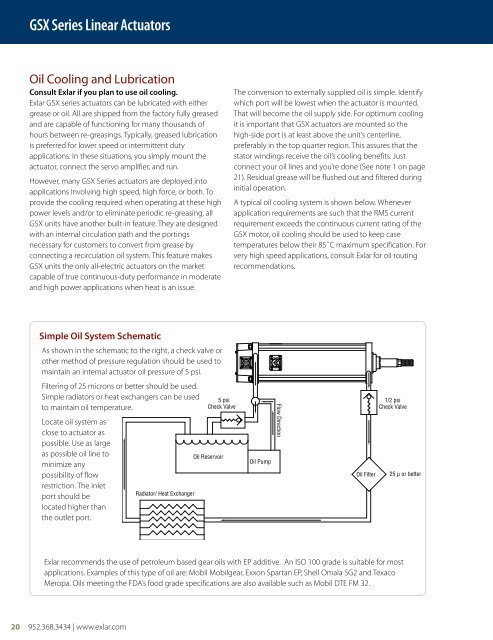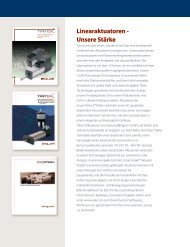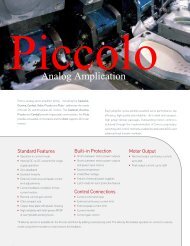GSX Series Linear Actuators
GSX Series Linear Actuators
GSX Series Linear Actuators
Create successful ePaper yourself
Turn your PDF publications into a flip-book with our unique Google optimized e-Paper software.
<strong>GSX</strong> <strong>Series</strong> <strong>Linear</strong> <strong>Actuators</strong><br />
Oil Cooling and Lubrication<br />
consult exlar if you plan to use oil cooling.<br />
Exlar <strong>GSX</strong> series actuators can be lubricated with either<br />
grease or oil. All are shipped from the factory fully greased<br />
and are capable of functioning for many thousands of<br />
hours between re-greasings. Typically, greased lubrication<br />
is preferred for lower speed or intermittent duty<br />
applications. In these situations, you simply mount the<br />
actuator, connect the servo amplifier, and run.<br />
However, many <strong>GSX</strong> <strong>Series</strong> actuators are deployed into<br />
applications involving high speed, high force, or both. To<br />
provide the cooling required when operating at these high<br />
power levels and/or to eliminate periodic re-greasing, all<br />
<strong>GSX</strong> units have another built-in feature. They are designed<br />
with an internal circulation path and the portings<br />
necessary for customers to convert from grease by<br />
connecting a recirculation oil system. This feature makes<br />
<strong>GSX</strong> units the only all-electric actuators on the market<br />
capable of true continuous-duty performance in moderate<br />
and high power applications when heat is an issue.<br />
Simple oil System Schematic<br />
As shown in the schematic to the right, a check valve or<br />
other method of pressure regulation should be used to<br />
maintain an internal actuator oil pressure of 5 psi.<br />
Filtering of 25 microns or better should be used.<br />
Simple radiators or heat exchangers can be used<br />
to maintain oil temperature.<br />
Locate oil system as<br />
close to actuator as<br />
possible. Use as large<br />
as possible oil line to<br />
Oil Reservoir<br />
minimize any<br />
possibility of flow<br />
restriction. The inlet<br />
Radiator/ Heat Exchanger<br />
port should be<br />
located higher than<br />
the outlet port.<br />
20 952.368.3434 | www.exlar.com<br />
The conversion to externally supplied oil is simple. Identify<br />
which port will be lowest when the actuator is mounted.<br />
That will become the oil supply side. For optimum cooling<br />
it is important that <strong>GSX</strong> actuators are mounted so the<br />
high-side port is at least above the unit’s centerline,<br />
preferably in the top quarter region. This assures that the<br />
stator windings receive the oil’s cooling benefits. Just<br />
connect your oil lines and you’re done (See note 1 on page<br />
21). Residual grease will be flushed out and filtered during<br />
initial operation.<br />
A typical oil cooling system is shown below. Whenever<br />
application requirements are such that the RMS current<br />
requirement exceeds the continuous current rating of the<br />
<strong>GSX</strong> motor, oil cooling should be used to keep case<br />
temperatures below their 85˚C maximum specification. For<br />
very high speed applications, consult Exlar for oil routing<br />
recommendations.<br />
5 psi 1/2 psi<br />
Check Valve<br />
Check Valve<br />
Oil Pump<br />
Flow Direction<br />
Oil Filter 25 µ or better<br />
Exlar recommends the use of petroleum based gear oils with EP additive. An ISO 100 grade is suitable for most<br />
applications. Examples of this type of oil are: Mobil Mobilgear, Exxon Spartan EP, Shell Omala SG2 and Texaco<br />
Meropa. Oils meeting the FDA’s food grade specifications are also available such as Mobil DTE FM 32.





